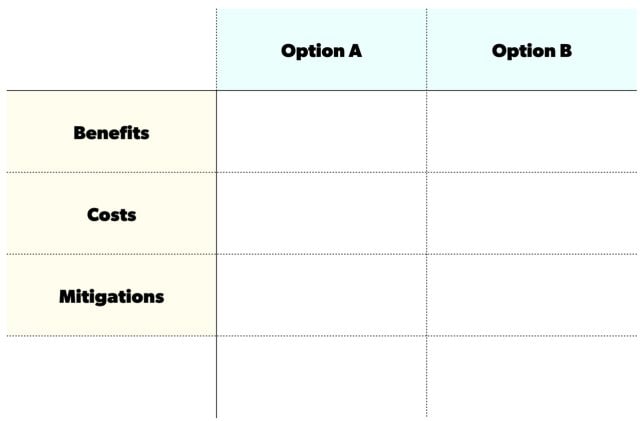- Valor Performance Blog
- What Leaders Need to Know About Making Decisions
What Leaders Need to Know About Making Decisions
Philosophers, researchers, mathematicians, and other scientists have studied the phenomena of decision-making for decades. It’s an act we perform constantly throughout our lives at varying degrees.
When it comes to desirable skills for managers, leaders, and executives to possess, decision-making ranks among the most important. And it’s easy to see why. As leaders, the decisions you make affect your team, your department, and even the entire organization. They affect customers, clients, and investors. The ability to make decisions thoughtfully, quickly, and with confidence is a skill that is essential for a strong leader to have but isn’t necessarily something that many of us think of as something to work on.
Effective Decision Making
The types of decisions leaders face can take many forms. There are long-term strategic decisions such as which project to greenlight and move forward with, which system or software to adopt to manage your operations, or which employees to promote. There are also short-term, quick decisions that need to be made in the moment, such as pivoting approaches during a client call to save a sale, taking action in an emergency if your software product goes down, or making a critical medical decision at the operating table.
The ability to confidently and effectively make these decisions not only will result in a better outcome, but also creates a ripple effect across your team, building stronger relationships, reinforcing the culture, establishing trust, and further bolstering your presence as a leader. Additionally, bringing a sense of consistency and order to your decision-making process is part of creating that feeling of confidence in your leadership abilities.
But not every inflection point or situation requires or is best served with the same approach. Sometimes, a group consensus is the best method. Other times, stakeholders want your wisdom and expertise to be the foundation for resolving a conflict. The ability to identify which approach to take to elicit the result you want is a skill you can develop and hone as you grow as a leader.
Here are some useful resources that can help you to develop better decision-making skills.
Quick decisions vs strategic decision making
Not every decision you will make requires a lengthy analysis of each variable to consider. In fact, many decisions we make don’t allow us the luxury of taking that kind of time. As leaders, we are valued for our decisiveness and are relied upon to be able to think quickly on our feet and make quick decisions in the moment. But how can we hone the instinctual ability to pivot in the moment or choose the right option?
A lot of it comes down to attention control, recognizing patterns in the decisions we face, and determining the risk involved in making the “wrong” decision. The more decisions we make–and pay attention to making–the better we become at recognizing the patterns, knowing what information to pay attention to, and whether or not the decision is reversible.
Strategic decision-making takes a bit more thought. These types of decisions may not always fall into the “one-way door” category but still require some real thought and consideration, especially when you consider some of the things at stake. Not every company has the resources of Amazon, so the number of “wrong decisions” or pivots are limited. Likewise, indecision or backtracking can erode the trust your team may have in your leadership. Time is a valuable resource as well. The time it takes to thoughtfully assess the bigger-picture decisions you are making will be less than the time it takes to see two different decisions through if you change your mind.
What interferes with our decision-making process?
The psychologist, author, and Nobel laureate Daniel Kahneman focuses his work and research primarily in the worlds of economics and finance, but his strategies for better decision-making have applications beyond just weighing financial risks. Kahneman posits that one of the biggest factors that can lead to unreliable decision making is what he calls noise, or the irrelevant but pervasive factors that influence decision-making, such as your current mood at the time, how hungry you may be, how much you are looking forward to your next appointment, or even the weather. Our biases are also a major factor that can derail our rational decision-making ability.
The impact that bias and noise can have on decision-making and performance is startling. Kahneman, and other researchers, uncovered divergence of the outcome at upwards of 56% in a study done with insurance underwriters processing the same case file, a 71% divergence on the estimated time it would take the same software developers to complete a project, and significantly varied results in a number of other cases in accounting, the outcome of legal verdicts, and real estate, to name a few.
In order to help mitigate the risk, increase consistency, and weed out the noise in making decisions, relying on a framework for decision making can be useful. Frameworks can help you identify WHO needs to be involved in the decision, HOW to go about coming to a decision, and WHAT your decision should ultimately be.
Decision-Making Techniques
There are numerous models used to evaluate decisions and assist in the decision-making process. Models can be especially useful when facing decisions that are new or you haven’t had to consider before. These can be used to analyze your decision but aren’t wholly comprehensive, as there are always emotions involved when making decisions in the real world.
The Vroom-Yetton Decision Model: This system helps to identify the leadership style best matched with the decision-making approach for each type of scenario leaders face. With five possible pathways to making the best decision, this model lays out a decision tree for which approach to take. This model can assist with identifying WHO should be involved with the decision-making process and HOW you should think about making the decision.
According to the model, the approach to decision making falls into the following categories:
- Consultative (C1): You inform your team of the situation and ask for opinions individually, but you don’t bring the group together for a discussion. You make the final decision.
- Autocratic (A1): You use the information that you already have and your own experience to make the decision, without requiring any further input from your team.
- Autocratic (A2): You consult your team to obtain the specific information that you need, and then you make the final decision.
- Consultative (C2): You get your team together for a group discussion about the issue and to seek their suggestions, but you still make the final decision by yourself.
- Collaborative (G2): You work with your team to reach a group consensus. Your role is mostly facilitative, and you help the group to reach a decision that everyone agrees on.
The decision tree looks like this:

Another helpful decision-making framework is Shklarski’s “Xanax for Decision Making” framework, designed by the Flatiron Health head of technology. This simple but effective system helps to improve “team alignment while reducing stress in the decision-making process.” This model is best when you already have a good idea of who should be a part of the process but need assistance figuring out HOW to decide and WHAT the best decision is by laying out the pros and cons.
First, determine whether the decision is a reversible or irreversible decision. Though the framework works for both styles, it was primarily designed for the former. By using a basic chart comparing two or more options, and identifying the costs, benefits, and uniquely, mitigations, you can clearly see the impact of choosing one option over another.

The mitigations column is a way of evaluating the options available while also naming the fears, concerns, and feasibility of choosing one of them. This is the space to discuss how to soften, allay, or distribute the risks associated with each of the options. Asking some questions to help fill out the mitigations column can be useful. Consider an objective perspective with these:
- What would be the best choice for our clients and customers?
- What would the board or larger leadership want us to do?
And try addressing the cost and risk from an alternative perspective with these:
- What is the root of the risk and how can we mitigate it?
- Can we address the costs (time, money, tech-debt) in other ways?
- Can we resolve the underlying concern or anxiety in other ways?
- Is there a short-term or long-term tradeoff we can make instead?
These are only two frameworks for determining the best approach and solution to decision-making. There are numerous other approaches and checklists that can assist you in this process. The idea is not to find one and adopt it exclusively, but to use these to inform the way you are thinking about and approaching the decision-making process for yourself and your team.
Evaluating your decision
No matter how complex or straightforward a decision, it can be broken down into distinct, basic components. The frameworks mentioned above expand upon the different steps, giving you tools for solving the problem of making a decision and providing guidance for how to approach and think through the “what ifs” in more detail. But if we step back and consider the individual components of the decision-making process, we can clearly see five distinct steps.
These are the steps that make up the anatomy of a decision:
- Identify the problem you are trying to solve
- Research and gather the information you need that is directly related to the problem
- Consider alternatives, and weigh the consequences of choosing one of those
- Make your decision and take action
- Evaluate your choice, assess the impact, and modify the course of action as needed
This final stage is possibly the most important part of any decision that you make. Your ability to take stock of what you have decided to do, honestly evaluate the success of this decision and the impact it had on the intended outcome, and address any unforeseen consequences will help you to make better decisions moving forward and will strengthen the foundation of your leadership within your team.
Ready to elevate your leadership skills through informed decision-making? Request a demo of Valor's Leadership Coaching today and solidify your path to becoming an effective and influential leader.


